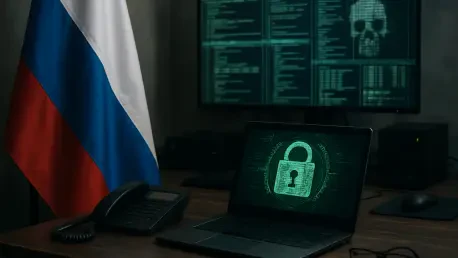In a rapidly digitizing world where cyber threats loom larger than ever, the intricate dance between the Russian government and cybercriminals has emerged as a critical geopolitical issue that demands close attention. A comprehensive report from Recorded Future’s Dark Covenant series sheds light on a striking evolution: Russia has transitioned from merely tolerating cybercrime to actively managing it as a tool for state interests. This shift is not a random occurrence but a calculated response to mounting geopolitical tensions, intensified international law enforcement efforts, and the need to maintain domestic political stability. What was once a shadowy relationship of convenience between state authorities and digital outlaws has transformed into a strategic partnership, raising profound questions about the future of global cybersecurity. This development signals a new era where cybercrime is not just a criminal enterprise but a lever of national power, intricately woven into the fabric of international relations and statecraft.
State-Cybercrime Collaboration
Historical Ties and Strategic Alignment
The relationship between Russian authorities and cybercriminals stretches back decades, rooted in a mutual understanding that allowed digital criminals to operate with near impunity as long as their activities aligned with or did not contradict state objectives. This unspoken pact often saw cybercriminals providing valuable intelligence or executing operations that indirectly supported governmental goals, creating a symbiotic dynamic. Intelligence and law enforcement agencies, in particular, have historically played a pivotal role in fostering these ties, offering protection in exchange for services. The 2022 invasion of Ukraine marked a turning point, as this collaboration became more overt, with certain cyber groups publicly aligning with the Kremlin’s agenda. Their actions, including targeted attacks on Ukrainian infrastructure, showcased how deeply intertwined these actors had become with state priorities, illustrating a partnership that transcends mere tolerance and veers into active cooperation.
This alignment, however, is not without its complexities, as not all cybercriminals have chosen to side with the state during critical geopolitical events. A notable divergence emerged during the Ukraine conflict, with some threat actors distancing themselves from the Kremlin’s objectives, either due to ideological differences or fear of international repercussions. This split highlights the fragile nature of loyalty within the cybercrime ecosystem, where personal gain often competes with state demands. While some groups continue to serve as proxies for Russian interests, others operate in a gray area, navigating the risks of both domestic enforcement and global sanctions. Such fragmentation underscores the challenge of maintaining a cohesive strategy when dealing with inherently independent and profit-driven entities. The historical impunity once enjoyed by these actors has evolved into a more structured, albeit uneven, partnership that reflects the state’s growing need to harness cyber capabilities for broader strategic aims.
Geopolitical Pressures and Responses
International Disruptions and State Reactions
The global cybersecurity landscape has shifted dramatically due to coordinated international efforts targeting cybercrime infrastructure, with initiatives like Operation Endgame striking at the heart of Russia’s long-standing reputation as a safe haven for digital criminals. This operation dismantled critical components such as botnets, malware loaders, and money laundering networks, sending shockwaves through the Russian cybercrime underground. The disruption forced a reevaluation of the traditional leniency afforded to these groups, as the international community’s resolve to combat cyber threats became undeniable. Russian authorities, caught between maintaining domestic control and responding to external pressures, have resorted to high-profile actions, including arrests and asset seizures, to project an image of compliance. Yet, these moves often appear more as geopolitical posturing than genuine attempts to eradicate cybercrime, revealing a calculated effort to mitigate global backlash while preserving strategic assets.
Beyond the immediate impact of such operations, the ripple effects on Russia’s cyber ecosystem are profound, as they challenge the state’s ability to balance external expectations with internal priorities. The public nature of these enforcement actions serves a dual purpose: it signals to the international community a willingness to act while simultaneously reinforcing domestic narratives of authority and control. However, the selective targeting of certain operations over others suggests that these responses are less about eliminating cybercrime and more about managing perceptions on a global stage. The state’s reaction to initiatives like Operation Endgame indicates a pivot toward using cybercrime as a diplomatic bargaining chip, where visible crackdowns mask the continued protection of groups deemed valuable. This delicate balancing act highlights the intricate interplay between international law enforcement pressure and Russia’s strategic use of cyber capabilities in the broader geopolitical arena.
Selective Enforcement Tactics
Russian authorities have adopted a highly strategic approach to managing cybercriminals, employing a cost-benefit analysis that prioritizes state interests over blanket enforcement. High-value groups, such as Conti and TrickBot, often linked to intelligence services, continue to operate with relative insulation, even as they face international scrutiny and sanctions. Their utility in conducting operations that align with national objectives—whether through espionage or disruption of foreign entities—affords them a level of protection that lower-tier actors lack. This selective enforcement creates a hierarchy within the cybercrime landscape, where alignment with state goals can mean the difference between freedom and prosecution. The state’s willingness to shield these groups underscores the extent to which cybercrime has become an extension of national policy, wielded as a tool of influence in an increasingly contested digital domain.
In contrast, cybercriminals deemed less useful or politically inconvenient often bear the brunt of enforcement, particularly when international pressure mounts. Following disruptions like Operation Endgame, Russian authorities have targeted lower-value financial facilitators, executing arrests and seizing assets to demonstrate responsiveness to global demands. These actions, often led by entities like the Investigative Committee rather than core security services, suggest a deliberate governance strategy rather than a commitment to eradication. The focus on expendable actors allows the state to maintain plausible deniability while preserving the operational capacity of strategically important groups. This calculated approach not only mitigates external criticism but also reinforces domestic control by sending a message to the cyber underground about the consequences of operating outside state-sanctioned boundaries. Such tactics reveal a nuanced policy where cybercrime is managed as both a liability and an asset.
Evolution of the Cybercrime Underground
Operational Adaptations and Distrust
The Russian cybercrime underground has undergone significant transformation in response to heightened scrutiny from both domestic authorities and international law enforcement. Threat actors are increasingly adopting decentralized structures, moving away from centralized operations that are more vulnerable to disruption. Stricter vetting processes for affiliates and the use of closed communication channels have become standard practices to evade surveillance and infiltration. A notable shift includes a growing preference for Russian-speaking partners over English-speaking ones, driven by fears of penetration by researchers or law enforcement posing as collaborators. This cultural exclusivity reflects a broader climate of distrust within the underground, where paranoia among ransomware affiliates has surged. The decline in open advertisements for ransomware-as-a-service (RaaS) programs further illustrates how these groups are adapting to a riskier operational environment by prioritizing security over visibility.
This atmosphere of suspicion has fundamentally altered the dynamics of collaboration within the cybercrime ecosystem, as trust becomes a scarce commodity. The fear of selective enforcement by Russian authorities, coupled with the threat of international sting operations, has led to operational silos where information sharing is minimized. Semi-closed recruitment for RaaS programs has emerged as a key adaptation, limiting access to trusted networks and reducing exposure to potential informants. These changes, while effective in mitigating immediate risks, also hinder the scalability and efficiency of cybercrime operations, as building new partnerships becomes a slower and more cautious process. The underground’s pivot to heightened operational security measures demonstrates a rational response to an increasingly hostile environment, where survival depends on anonymity and discretion. Yet, this fragmentation raises questions about the long-term sustainability of such a fractured and distrustful community.
Resilience Amid Challenges
Despite the mounting pressures, the Russian cybercrime underground continues to demonstrate remarkable resilience, with new programs emerging to replace those disrupted by enforcement actions. Over the past year, roughly a dozen new RaaS operations have surfaced, signaling that the business model remains lucrative even in a more guarded landscape. This persistence is driven by the high financial rewards of cybercrime, which continue to attract both seasoned operators and newcomers despite the elevated risks. The adaptability of these groups is evident in their ability to innovate under constraint, finding ways to exploit vulnerabilities in global digital systems while navigating domestic and international threats. While trust barriers have risen, the core appeal of cybercrime as a profitable enterprise endures, ensuring that the ecosystem evolves rather than collapses under pressure. This enduring attractiveness underscores the difficulty of dismantling such networks through enforcement alone.
However, the challenges of operating in this new reality cannot be understated, as the underground grapples with internal fragmentation and external threats that test its cohesion. The paranoia and cultural exclusivity that now define recruitment and collaboration have created higher entry barriers, slowing the pace at which new operations can scale. Yet, the adaptability of cybercriminals is a testament to their resourcefulness, as they leverage encrypted platforms and localized networks to maintain operations. The balance between risk and reward remains a central tension, with many actors willing to endure heightened scrutiny for the promise of substantial gains. This resilience suggests that while enforcement efforts can disrupt specific groups, the broader cybercrime model in Russia is far from defeated. Instead, it continues to morph, finding new ways to thrive amid adversity and reflecting the complex interplay of state management and criminal ingenuity.
Governance Over Eradication
Active Management and Public Messaging
Since 2023, the Russian government has clearly shifted from a passive enabler to an active manager of cybercrime, orchestrating public displays of authority to navigate a delicate balance of external pressures and domestic needs. High-profile arrests and asset seizures, often publicized with significant fanfare, serve as tools of political messaging, projecting an image of control to both international observers and the domestic populace. These actions are carefully choreographed to address global criticism while maintaining the strategic utility of cybercriminal proxies who align with state interests. Rather than aiming for the complete eradication of cybercrime, this approach reflects a governance strategy designed to regulate the digital underground as a resource. The state’s ability to wield cybercrime as a geopolitical instrument, while simultaneously managing perceptions of compliance, highlights a sophisticated understanding of the dual role these actors play in national strategy.
This active management also serves to reinforce internal narratives of state power, ensuring that the government appears responsive to cyber threats even as it protects key players in the ecosystem. The choice of which groups to target often hinges on their perceived value to national objectives, with those lacking strategic importance becoming scapegoats in public crackdowns. Such selective actions send a clear signal to the cyber underground about the boundaries of acceptable behavior, while preserving the operational capacity of groups critical to state goals. The emphasis on visible enforcement, rather than systemic reform, underscores a pragmatic approach where cybercrime is treated as a manageable asset rather than an existential threat. This nuanced governance reveals the extent to which digital crime has been integrated into broader statecraft, serving as both a weapon and a liability that requires careful calibration to maximize benefits while minimizing risks.
Strategic Equilibrium and Future Implications
Looking back, the Russian government’s handling of cybercrime over recent years demonstrated a calculated effort to maintain a strategic equilibrium, balancing the utility of digital proxies with the need to mitigate international backlash. Publicized enforcement actions, often targeting less critical actors, were paired with the quiet protection of high-value groups, reflecting a deliberate policy of selective tolerance. This approach allowed the state to leverage cyber capabilities for geopolitical influence while addressing external pressures through visible, albeit limited, interventions. The persistence of new cybercrime programs, even amidst heightened scrutiny, pointed to the enduring appeal of the business model, which continued to adapt to a changing landscape. The interplay between state management and underground resilience shaped a complex dynamic that neither fully eradicated nor fully endorsed cybercrime but rather governed it as a strategic tool.
Reflecting on these developments, it becomes evident that future strategies must focus on disrupting the incentives that sustain this ecosystem, rather than relying solely on enforcement actions that often target only the periphery. International collaboration should prioritize dismantling the financial networks that fuel cybercrime, while diplomatic efforts could aim to shift the cost-benefit calculus for state actors who manage these groups. For policymakers, understanding the nuanced relationship between the Russian state and cybercriminals is crucial to crafting effective countermeasures that address both the criminal and geopolitical dimensions. Moving forward, sustained pressure through targeted sanctions and cyber infrastructure disruptions could alter the safe haven dynamics, while fostering global norms on state accountability in cyberspace remains essential. These steps, though challenging, offer a pathway to reshape the environment in which cybercrime operates as a state-sponsored tool.









